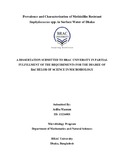| dc.contributor.advisor | Siddiqee, Mahbubul Hasan | |
| dc.contributor.author | Masnun, Adiba | |
| dc.date.accessioned | 2018-11-28T10:31:13Z | |
| dc.date.available | 2018-11-28T10:31:13Z | |
| dc.date.copyright | 2018 | |
| dc.date.issued | 2018-10 | |
| dc.identifier.other | ID 13226003 | |
| dc.identifier.uri | http://hdl.handle.net/10361/10897 | |
| dc.description | This thesis is submitted in partial fulfilment of the requirements for the degree of Bachelor of Science in Microbiology, 2018. | en_US |
| dc.description | Catalogued from PDF version of thesis report. | |
| dc.description | Includes bibliographical references (page 33-36). | |
| dc.description.abstract | Dhaka city being the capital of Bangladesh faces problem with rapid urbanization based on ruralto-
urban migration often results in the contamination of water bodies with bacteria pathogenic to
humans. This study aims to determine the prevalence of environmental Staphylococcus spp.
contamination in water with industrial wastes, specifically focusing on Staphylococcus aureus. A
total of 35 water samples were collected from both Hatirjheel Lake and Buriganga River,
representing Dhaka city’s water bodies. Then they were processed for isolation of cultureable
Staphylococcus spp. strains. For this, the collected water samples were first plated on to
Mannitol Salt Agar (MSA). One pure colony from each positive plate was then selected for
further processing. Presumptive isolates were then confirmed using biochemical methods. To
determine whether they are Staphylococcus aureus or not. After that hemolytic activity on the
samples were observed by inoculating them on Blood Agar and it showed 100% hemolysis for
isolates from Hatirjheel and 82.35% for those from Buriganga. For determining the virulent
activity of the strains, coagulase test was done and 72.22% coagulase positive were observed for
Hatirjheel-isolates and 71% Buriganga-isolates. Antibiotic susceptibility test showed similar
results for Hatirjheel Lake and Buriganga River, except for methicillin-resistance. Resistance to
methicillin was found in 5.56% of the Hatirjheel-isolates whereas 35.50% of the Burigangaisolates
were MRSA. This study reveals that both Hatirjheel Lake and Buriganga River are
contaminated with Staphylococcus spp.that may lead to serious health hazard in near future. | en_US |
| dc.description.statementofresponsibility | Adiba Masnun | |
| dc.format.extent | 51 pages | |
| dc.language.iso | en | en_US |
| dc.publisher | BRAC University | en_US |
| dc.rights | BRAC University theses are protected by copyright. They may be viewed from this source for any purpose, but reproduction or distribution in any format is prohibited without written permission. | |
| dc.subject | Dhaka | en_US |
| dc.subject | Staphylococcus spp. | en_US |
| dc.subject | Mannitol Salt Agar | en_US |
| dc.subject | Methicillin resistant | en_US |
| dc.subject.lcsh | Methicillin resistance. | |
| dc.subject.lcsh | Medical -- Infectious Diseases. | |
| dc.subject.lcsh | Staphylococcus aureus infections. | |
| dc.title | Prevalence and characterization of methicillin resistant staphylococcus spp. in surface water of Dhaka | en_US |
| dc.type | Thesis | en_US |
| dc.contributor.department | Department of Mathematics and Natural Sciences, BRAC University | |
| dc.description.degree | B. Microbiology | |

